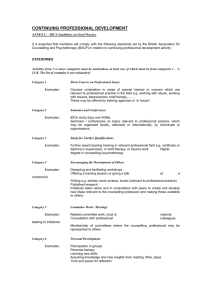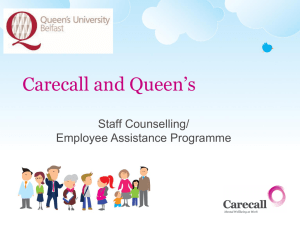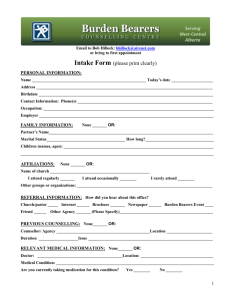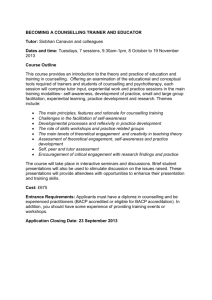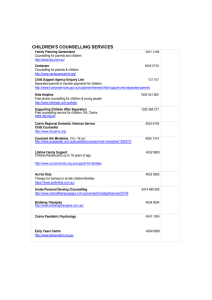Unlocking impact: Five key questions – Malen Davies
advertisement
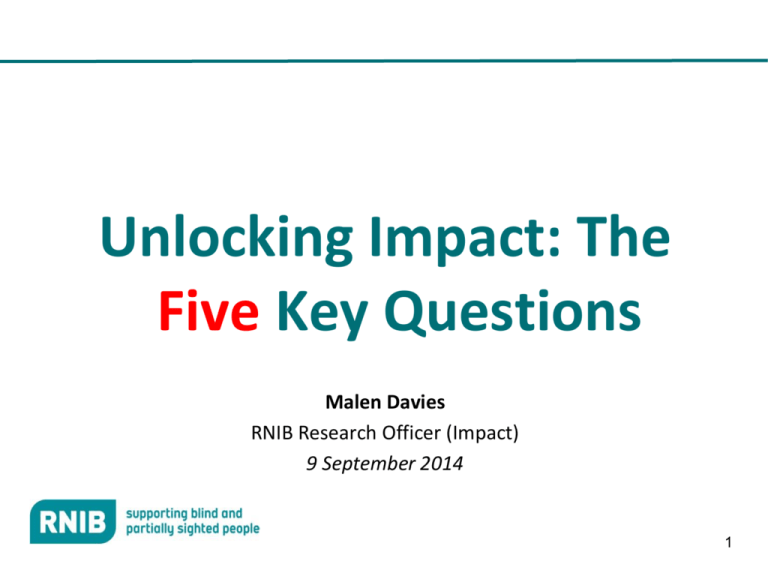
Unlocking Impact: The Five Key Questions Malen Davies RNIB Research Officer (Impact) 9 September 2014 1 Part One: Defining Success What you do and what happens when you do it 2 Part One: Defining Success What you do and what happens when you do it Lunch club model 3 Part One: Defining Success Five key questions 1. Why measure outcomes and impact? 2.What does success look like…exactly? 3. How are you going to make change happen? 4. Who needs to know you are being successful? 5. How are you going to know you're being successful? 4 Part One: Defining Success First Key Question: Why measure outcomes and impacts? 5 Part One: Defining success Why measure outcomes and impact? • Finding out progress against mission • Learning how to improve • Secure funding • Inspiring staff and improving their work • Raising profile • Contributing to knowledge of ‘what works’ 6 Part One: Defining Success Second Key Question: What does success look like? 7 OutPart One: Defining Successcome types Outcome type • • • • Knowledge & Skill - "I know more" Emotional - "I feel different" Behavioural - "I act different" Opportunity - "I have a chance I didn't before" • Economic - "I am financially better off" • Health - "My health has improved" Part One: Defining Success 9 Part One: Defining Success Second Key Question: What does success look like…exactly? (What are your intended outcomes?) 10 Part Two: Creating Change Third Key Question: How are you going to make change happen? 11 Part Two: Creating Change Theory of change Inputs Activities Outputs Outcomes Impacts 12 Impact Map Inputs What are the resources used to run activities and fulfil your objectives? Activities What are the projects or processes that allow you to fulfil your objectives? Outputs What is produced as a direct result of these actions? Usually depicting completion of activity Outcomes Impacts What benefit or change is accomplished as a direct result of the output? 13 Part Two: Creating Change Theory of change: Counselling service Inputs 3 part time counsellors Activities Counselling up to 10 clients each month Outputs 360 people a year provided with counselling Outcomes Impacts Empower more people with sight loss 14 Part Two: Creating Change Theory of change: Counselling service Inputs 3 part time counsellors Activities Outputs Outcomes Impacts Counselling up to 10 clients each month 360 people a year provided with counselling Empower more people with sight loss Challenging assumptions External factors Are they qualified? Who is financing project? Is there need for this much support? Is there other support delivered outside of counselling? 15 Part Two: Creating Change 16 Part Two: Creating Change Fourth Key Question: How are you going to make success happen? Building a theory of change group exercise 17 Part two: Creating Change Exercise: building a theory of change Plan a theory of change for a new telebefriending service for people with sight loss aged over 65 years old. 18 Part two: Creating Change Theory of change Inputs Activities -Staff time. -Telebefriending groups set up -Volunteer time -Volunteers trained to become telebefriending facilitators - Grant funding - Develop training guides and resources for groups Outputs Outcomes / Impact -50 telebefriending groups set -Improve sense of well-being for customers up -Increased quality of life for customers - 20 volunteers trained - Volunteers improve knowledge and skills - Information and resources provided to telebefriending groups Part Two: Creating Change Theory of Change: • Help teams work together to achieve a shared understanding of a project and its aims. • Bring the process of change to the forefront. • Make projects more effective • Quickly communicate a project’s aims • Encourage teams to engage with the existing evidence base 20 Part Three: Planning Measurement Fourth Key Question: Who needs to know you are being successful? 21 Part Three: Planning Measurement Who wants to know and what do they want? Who needs to know what do they need? 22 Part Three: Planning Measurement Fourth Key Question: Who needs to know you are being successful? (Identify your audience) 23 Part Four: Measuring Success Fifth Key Question: How are you going to know you're being successful? 24 Part Four: Measuring Success Impact Measurement Tools and Tips 25 Part Four: Measuring Success Principles of Impact Measurement 1. 2. 3. 4. 5. 6. Clarity - The reader can quickly and easily understand the intervention through a coherent narrative that connects charitable aims, plans, activities and results Accessibility - Relevant information can be found by anyone who looks for it, in a range of formats suitable for different stakeholders Transparency - Reporting is full, open and honest Accountability - Reporting connects with stakeholders, partners and beneficiaries to tell them what they need to know; Verifiability - Claims about impact are backed up appropriately, allowing others to review Proportionality - The level and detail of reporting reflects the size of the intervention Charity Finance Group, ACEVO & NPC (2012) 26 Part Four: Measuring Success Technical and Established Methodologies Example: Social Return on Investment (free): http://www.thesroinetwork.org/ 27 Part Four: Measuring Success Casework Measures Examples: Outcomes Star (cost): http://www.outcomesstar.org.uk/ Rickter Scale (cost): http://www.rickterscale.com/ 28 Part Four: Measuring Success Validated Questionnaires Example: Warwick-Edinburgh Mental Well-Being Scale (free): http://www.healthscotland.com/scotlandshealth/population/Measuring-positive-mentalhealth.aspx 29 Part Four: Measuring Success Bespoke Tools Examples: Semi-Structured Outcome Questionnaires, Focus Groups, Diary Studies, Social Media. 30 Part Four: Measuring Success Deciding Which Measure to Use 1. Audience 2. Resource 3. Access 31 Part Four: Measuring Success Tips for success •Be as clear as possible about the outcomes you're trying to measure - without this you will struggle measure them! •Be flexible with you measurement methods - good evidence needs good research principles, but it can be done in flexible and 'natural' ways, through conversation and existing opportunities to engage with customers 32 Part Four: Measuring Success Tips for success •Explain to customers your rationale - evaluation need not be cold or abstract. Explain to your customers why you need to collect impact information, and why it's important for you, them and other customers 33 Part Five: Communicate Success Communicate Your Evidence! Example: Annual Report Format Why we're doing this (Need) What we did (Activity) What difference it makes (Impact) 34 Unlocking Impact: The Five Key Questions 1. Why measure outcomes and impact? 2.What does success look like…exactly? 3. How are you going to make change happen? 4. Who needs to know you are being successful? 5. How are you going to know you're being successful? 35 Useful links New Philanthropy Capital: https://www.thinknpc.org/publications/the-principles-ofgood-impact-reporting-2/ CENI: http://www.ceni.org/evaluation-impactmeasurement Impact HUB: http://inspiringimpact.org/listings/ 36 Questions Malen Davies Research Officer (Impact) Malen.davies@rnib.org.uk 37
